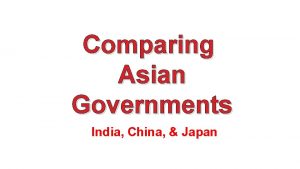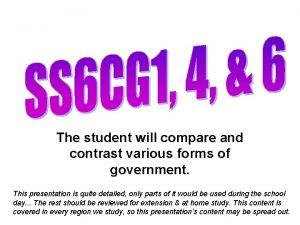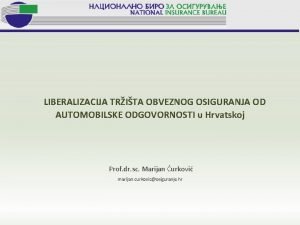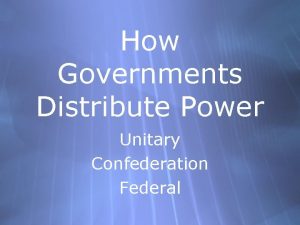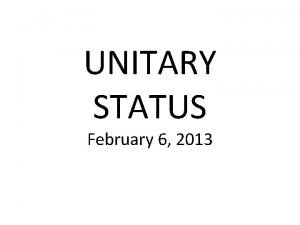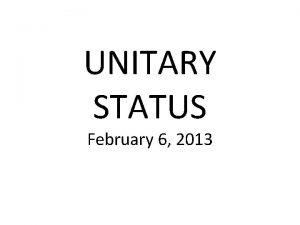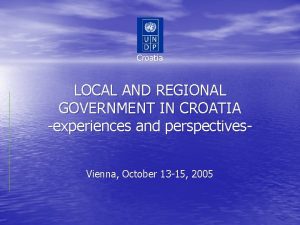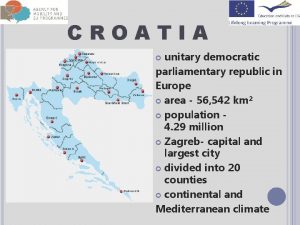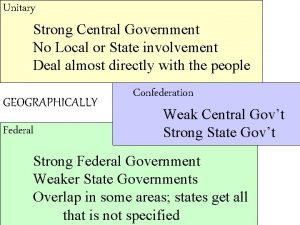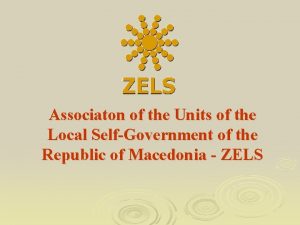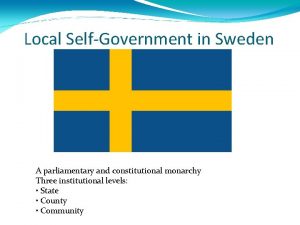Local selfgovernment in Croatia INTRODUCTION A unitary state














- Slides: 14

Local self-government in Croatia

INTRODUCTION: - A unitary state. A parliamentary democracy. TWO TIERS OF LOCAL SELF-GOVERNMENT: Municipalities. Counties. PROCESS OF DECENTRALIZATION: 1992: Local self-government and administration Act. 1997: European Charter of Local Self-Government. 2000: Constitutional amendments: principle of subsidiarity + importance of local and regional government. 2001: Law on local self-government.

The Local Government System A. Local Government Law 1. A right enshrined in the constitution o March 28, 2001: the Constitution is reformed: Article VI on local and regional autonomy - Affirmed principle of separation of powers - Importance of local and regional government - Provisions modelled on the European Charter of Local Self-Government - Local authorities’ rights at the constitutional level

2. The direct participation of citizens in the decision-making process Local / Regional Referendums - The power belongs to the people as a community of free and equal citizens. - A law may be adopted by referendum Other Forms of Direct Participation - Advisory referendum - Local assembly of citizens - Complaints from citizens

B- LOCAL GOVERNMENT ORGANIZATION - Municipalities : Towns and Communes Under 3, 000 inhabitants 3, 000 to 10, 000 10, 001 to Over 30, 000 Zagreb 30, 000 Deliberative body Town/Municipality Councils. Members elected for 4 years. Direct Universal Suffrage. Proportional Representation System Number of members on the Council Executive authorithy 7 to 13 9 to 15 13 to 19 19 to 35 Individual Executive Power (Town and Commune Mayor) with one or two vice-mayors depending on the size of local units (under or over 10, 000 inhabitants). Direct Election by the citizens. 51

B- LOCAL GOVERNMENT ORGANIZATION - Counties Deliberative Body The County Council Election Elected for 4 years, direct universal suffrage, proportional representation system Prerogatives County Representation and County Affairs Number of Members from 31 to 51 councillors Council Chairman Elected among its members. Head of the county assembly Executive Body The County Mayor and Two Deputy-Mayors, directly elected by the citizens

Regional assembly Election Prerogatives Number of members Chairman of the assembly Executive authority Elected for 4 years, direct universal suffrage, election on a proportional basis Regional representation and regional stuff, affairs Odd number, between 31 and 51 Elected among its members, head of the regional assembly Odd number of members (between 7 and 13), elected by the regional assembly Zagreb Municipalities Regions 17 districts, a council is elected by the inhabitants of each district Same organisation as for the other regions The affairs of the two scale local self-government: Council (Mayor + two members of the town council + the regional assembly chairman + two members of the regional assembly

2 -Right of the minorities and status of the local elected councillors. MINORITIES LOCAL COUNCILLORS’ RIGHTS AND DUTIES Charter of local self-government Regulations of the council

Local Policy A- Local Government Responsibilities CONSTITUTION : Right to local and regional self-government. Provisions defining the respective powers of the local and regional. LOCAL SELF-GOVERNMENT ACT, 2001 : Responsibilities are devolved from the central government Public affairs are local self-governments’ own responsibility

Local Policy B- Local Government Budget and Finance 1) Local Government Expenditures Main types of expenditure (as in 2001): - housing (69%) - administration (21%) - transport, sport and culture (13%) - education (11%) Total expenses in 2007: HRK 11. 9 billion (11. 7% increase with regard to 2006). • Compensation of employees: 25% of total expenses, • Use of goods and services: 39%, • other expenses and donations: 19% • others (subsidies, grants, social benefits and interests): 17%.

2) Revenues According to the law, local freedom in the use of non-tax revenue • Total amount of revenues of cities and counties in 2007: HRK 15. 5 billions (a 14. 3% increase compared to 2006) Most important sources of revenue (as in 2007): - tax revenue : 59% - non-tax revenue: 34% - grants : 6% - loans : 1%

Own tax revenue - 8% of total local revenue - Cities freely determine the rate of their local taxes. - Cities have many tax revenues Shared tax revenue - 84% of total tax revenue - 3 types of shared taxes : - income tax is shared by the central government, regions and cities - business tax is shared by the central government and cities - tax on property sale is shared by the central government and cities

Non-tax revenues - From concessions for the exploitation of mineral waters, spas and drinking water - Loans - Other revenues Central Government Grants - 6% of total local revenues - Shared allocations of non-tax revenue Transfers and subsidies - unequal assignment - some special statuses still exist

CONCLUSION Some resistance experienced during the first step in the decentralization reform In 2002 the Senate’s mission assessed the difficulties in the decentralization reform: - co-operation with the central government is difficult - a priori control is still in practice - tax revenues vary too much among communities - transfers from central to local government are insufficient
 Is japan a unitary state
Is japan a unitary state Unitary form
Unitary form Croatia minimum wage
Croatia minimum wage Rx
Rx Croatia koppen climate
Croatia koppen climate Ministry of agriculture croatia
Ministry of agriculture croatia Carnival croatia
Carnival croatia Croatia capital
Croatia capital Ministry of agriculture croatia
Ministry of agriculture croatia Soc croatia
Soc croatia Rwe hrvatska
Rwe hrvatska Croatia osiguranje prijenos bonusa
Croatia osiguranje prijenos bonusa Longest river in croatia
Longest river in croatia Local vertical local horizontal frame
Local vertical local horizontal frame A think local act local multicountry type of strategy
A think local act local multicountry type of strategy
